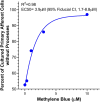Adverse effects of methylene blue in peripheral neurons: An in vitro electrophysiology and cell culture study
- PMID: 36408567
- PMCID: PMC9730009
- DOI: 10.1177/17448069221142523
Adverse effects of methylene blue in peripheral neurons: An in vitro electrophysiology and cell culture study
Abstract
Methylene blue (MB) is an effective treatment for methemoglobinemia, ifosfamide-induced encephalopathy, cyanide poisoning, and refractory vasoplegia. However, clinical case reports and preclinical studies indicate potentially neurotoxic activity of MB at certain concentrations. The exact mechanisms of MB neurotoxicity are not known, and while the effects of MB on neuronal tissue from different brain regions and myenteric ganglia have been examined, its effects on primary afferent neurons from dorsal root ganglia (DRG) have not been studied. Mouse DRG were exposed to MB (0.3-10 μM) in vitro to assess neurite outgrowth. Increasing concentrations of MB (0.3-10 μM) were associated with neurotoxicity as shown by a substantial loss of cells with neurite formation, particularly at 10 μM. In parallel experiments, cultured rat DRG neurons were treated with MB (100 μM) to examine how MB affects electrical membrane properties of small-diameter sensory neurons. MB decreased peak inward and outward current densities, decreased action potential amplitude, overshoot, afterhyperpolarization, increased action potential rise time, and decreased action potential firing in response to current stimulation. MB induced dose-dependent toxicity in peripheral neurons, in vitro. These findings are consistent with studies in brain and myenteric ganglion neurons showing increased neuronal loss and altered membrane electrical properties after MB application. Further research is needed to parse out the toxicity profile for MB to minimize damage to neuronal structures and reduce side effects in clinical settings.
Keywords: dorsal root ganglion; immunocytochemistry; methylene blue; neurite; neurotoxicity.
Conflict of interest statement
The author(s) declared no potential conflicts of interest with respect to the research, authorship, and/or publication of this article.
Figures





Similar articles
-
Methylene blue induces ongoing activity in rat cutaneous primary afferents and depolarization of DRG neurons via a photosensitive mechanism.Naunyn Schmiedebergs Arch Pharmacol. 1997 Nov;356(5):619-25. doi: 10.1007/pl00005098. Naunyn Schmiedebergs Arch Pharmacol. 1997. PMID: 9402042
-
7, 8, 3'-Trihydroxyflavone Promotes Neurite Outgrowth and Protects Against Bupivacaine-Induced Neurotoxicity in Mouse Dorsal Root Ganglion Neurons.Med Sci Monit. 2016 Jul 2;22:2301-8. doi: 10.12659/msm.896961. Med Sci Monit. 2016. PMID: 27371503 Free PMC article.
-
Insulin-like growth factor-1 attenuates apoptosis and protects neurochemical phenotypes of dorsal root ganglion neurons with paclitaxel-induced neurotoxicity in vitro.Nutr Neurosci. 2017 Feb;20(2):89-102. doi: 10.1179/1476830514Y.0000000147. Epub 2016 Mar 2. Nutr Neurosci. 2017. PMID: 25136768
-
Methylene blue: a controversial diagnostic acid and medication?Toxicol Res (Camb). 2022 Aug 30;11(5):711-717. doi: 10.1093/toxres/tfac050. eCollection 2022 Oct. Toxicol Res (Camb). 2022. PMID: 36337249 Free PMC article. Review.
-
Cellular and molecular actions of Methylene Blue in the nervous system.Med Res Rev. 2011 Jan;31(1):93-117. doi: 10.1002/med.20177. Med Res Rev. 2011. PMID: 19760660 Free PMC article. Review.
References
Publication types
MeSH terms
Substances
LinkOut - more resources
Full Text Sources
Miscellaneous

